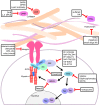The 2016 John J. Abel Award Lecture: Targeting the Mechanical Microenvironment in Cancer
- PMID: 27742780
- PMCID: PMC5118638
- DOI: 10.1124/mol.116.106765
The 2016 John J. Abel Award Lecture: Targeting the Mechanical Microenvironment in Cancer
Abstract
Past decades of cancer research have mainly focused on the role of various extracellular and intracellular biochemical signals on cancer progression and metastasis. Recent studies suggest an important role of mechanical forces in regulating cellular behaviors. This review first provides an overview of the mechanobiology research field. Then we specially focus on mechanotransduction pathways in cancer progression and describe in detail the key signaling components of such mechanotransduction pathways and extracellular matrix components that are altered in cancer. Although our understanding of mechanoregulation in cancer is still in its infancy, some agents against key mechanoregulators have been developed and will be discussed to explore the potential of pharmacologically targeting mechanotransduction in cancer.
Copyright © 2016 by The American Society for Pharmacology and Experimental Therapeutics.
Figures

References
-
- Arribas SM, Hinek A, González MC. (2006) Elastic fibres and vascular structure in hypertension. Pharmacol Ther 111:771–791. - PubMed
-
- Aruffo A, Stamenkovic I, Melnick M, Underhill CB, Seed B. (1990) CD44 is the principal cell surface receptor for hyaluronate. Cell 61:1303–1313. - PubMed
-
- Baker AM, Bird D, Lang G, Cox TR, Erler JT. (2013) Lysyl oxidase enzymatic function increases stiffness to drive colorectal cancer progression through FAK. Oncogene 32:1863–1868. - PubMed
Publication types
MeSH terms
Grants and funding
LinkOut - more resources
Full Text Sources
Other Literature Sources
Miscellaneous

